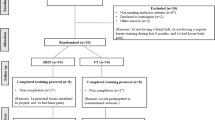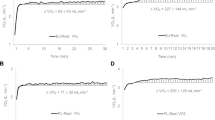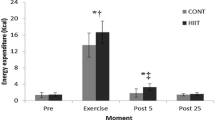Abstract
To evaluate the effect of warm up on energy cost and energy sources of a ballet dance exercise, 12 adolescent talented female dancers performed a ballet exercise (30 s of tours piqués en dedans on pointe) without and following a warm up. Warm up consisted in a light running followed by a period of stretching and two ballet exercises. The overall energy requirement of dance exercise (VO2eq) was obtained by adding the amount of VO2 during exercise above resting (aerobic source or VO2ex) to the VO2 up to the fast component of recovery (anaerobic alactic source or VO2al) and to the energy equivalent of peak blood lactate accumulation (anaerobic lactic source or \({\hbox{VO}_{{\rm 2la}^{-}}}\)) of recovery. VO2eq of exercise preceded by warm up amounted to 37 ± 3 ml kg−1. VO2al represented the higher fraction (50 ± 6%) of VO2eq, the remaining fractions were: 39 ± 5% for VO2ex and 11 ± 3% for \({\hbox{VO}_{{\rm 2la}^{-}}}\) . VO2eq of exercise without warm up amounted to 38 ± 3 ml kg−1. This value was made up of: 26 ± 6% by VO2ex, 56 ± 6% by VO2al and 18 ± 3% by \({\hbox{VO}_{{\rm 2la}^{-}}.}\) Between exercise conditions, significant differences were found in VO2ex (P < 0.01), \({\hbox{VO}_{{\rm 2la}^{-}}}\) (P < 0.01), and VO2al (P < 0.05). The metabolic power requirement, 1.6 times higher than subject’s \({\dot{\hbox{V}}\hbox{O}_{2\max},}\) indicates a very demanding exercise. The anaerobic alactic source was the most utilized. It can be concluded that, when dance exercise was preceded by warm up, the anaerobic sources contribution decreased whereas the aerobic energy source increased.

Similar content being viewed by others
Notes
Before its calculation, each point value of \({\dot{\hbox{V}}\hbox{O}_{2}}\) curve expressed as oxygen consumption per minute (ml kg−1 min−1) (Fig. 1a, b) was transformed into a VO2 value that is an averaged amount of oxygen consumption (ml kg−1) during 10 s
References
Andzel WD (1982) One mile run performance as a function of prior exercise. J Sports Med Phys Fitness 22:80–84
Baldari C, Guidetti L (2001) \({\dot{\hbox{V}}\hbox{O}_{2\max},}\) ventilatory and anaerobic thresholds in rhythmic gymnasts and young female dancers. J Sport Med Phys Fitness 41:177–182
Beneke R, Pollmann C, Bleif I, Leithäuser RM, Hütler M (2002) How anaerobic is he Wingate anaerobic test for humans? Eur J Appl Physiol 87:388–392
Beneke R, Hütler M, Jung M, Leithäuser RM (2005) Modeling the blood lactate kinetics at maximal short-term exercise conditions in children, adolescents, and adults. J Appl Physiol 99:499–504
Bishop D (2001) Evaluation of the Accusport lactate analyzer. Int J Sports Med 22:525–530
Bishop D (2003a) Warm Up I: potential mechanisms and the effects of passive warm up on exercise performance. Sports Med 33:439–454
Bishop D (2003b) Warm Up II: performance changes following active warm up and how to structure the warm up. Sports Med 33:483–498
Bruyn-Prevost P, Lefebvre F (1980) The effects of various warming up intensities and durations during a short maximal anaerobic exercise. Eur J Appl Physiol 43:101–107
Capelli C, Antonutto G, Zamparo P, Girardis M, di Prampero PE (1993) Effects of prolonged cycle ergometer exercise on maximal muscle power and oxygen uptake in humans. Eur J Appl Physiol 66:189–195
Clarkson PM, Freedson PS, Keller BK, Carney D, Skrinar M (1985) Maximal oxygen uptake, nutritional patterns and body composition of adolescent female ballet dancers. Res Q Exerc Sport 56:180–184
di Prampero PE (1981) Energetics of muscular exercise. Rev Physiol Biochem Pharmacol 89:143–222
di Prampero PE, Davies CT, Cerretelli P, Margaria R (1970) An analysis of O2 debt contracted in submaximal exercise. J Appl Physiol 29:547–551
Duncan GE, Howley ET, Johnson BN (1997) Applicability of \({\dot{\hbox{V}}\hbox{O}_{2\max}}\) criteria: discontinuous versus continuous protocols. Med Sci Sports Exerc 29:273–278
Febbraio MA, Carey MF, Snow RJ, Stathis CG, Hargreaves M (1996) Influence of elevated muscle temperature on metabolism during intense, dynamic exercise. Am J Physiol 271:R1251–R1255
Francescato MP, Talon T, di Prampero PE (1995) Energy cost and energy sources in karate. Eur J Appl Physiol 71:355–361
Gastin PB (2001) Energy system interaction and relative contribution during maximal exercise. Sports Med 31:725–741
Gollnick PD, Armstrong RB, Sembrowich WL, Shepherd RE, Saltin B (1973) Glycogen depletion pattern in human skeletal muscle fibres after heavy exercise. J Appl Physiol 34:615–618
Guidetti L, Baldari C, Capranica L, Persichini C, Figura F (2000) Energy cost and energy sources of ball routine in rhythmic gymnasts. Int J Sports Med 21:205–209
Gutin B, Stewart K, Lewis S, Kruper J (1976) Oxygen consumption in the first stages of strenuous work as a function of prior exercise. J Sports Med Phys Fitness 16:60–65
Hausswirth C, BigardAX, Lechevelier JM (1997) The Cosmed K4 telemetric system as an accurate device for oxygen uptake measurement during exercise. Int J Sport Med 18:449–453
Ingjer F, Stromme SB (1979) Effects of active, passive or no warm up on the physiological response to heavy exercise. Eur J Appl Physiol 40:273–282
Jones AM, Koppo K, Burnley M (2003) Effects of prior exercise on metabolic and gas exchange responses to exercise. Sports Med 33:949–971
Karvonen J (1992) Importance of warm up and cool down on exercise performance. In: Karvonen J, Lemon PWR, Live I (eds) Medicine and sport training and coaching. Karger, Basel, pp 190–213
Koga S, Shiojiri T, Kondo N, Barstow TJ (1997) Effect of increased muscle temperature on oxygen uptake kinetics during exercise. J Appl Physiol 83:1333–1338
Komi PV, Karlsson J (1979) Physical performance, skeletal muscle enzyme activities, and fibre types in monozygous and dizygous twins of both sexes. Acta Physiol Scand Suppl 462:1–28
Malareki I (1954) Investigation of physiological justification of so called ‘warming up’. Acta Physiol Pol 5:543–546
McCutcheon LJ, Geor RJ, Hinchcliff KW (1999) Effects of prior exercise on muscle metabolism during sprint exercise in horses. J Appl Physiol 87:1914–1922
Medbø JI, Tabata I (1989) Relative importance of aerobic and anaerobic energy release during short-lasting exhausting bicycle exercise. J Appl Physiol 67:1881–1886
Metra M, Raddino R, Dei Cas L, Visioli O (1990) Assessment of peak oxygen consumption, lactate and ventilatory thresholds and correlation with resting and exercise hemodynamic data in chronic congestive heart failure. Am J Cardiol 65:1127–1133
Özyener F, Rossiter HB, Ward SA, Whipp BJ. (2001) Influence of exercise intensity on the on- and off-transient kinetics pulmunary oxygen uptake in humans. J Physiol 533:891–900
Saltin B, Gagge AP, Stolwijk JAJ (1968) Muscle temperature during submaximal exercise in man. J Appl Physiol 25:679–688
Schantz PG, Astrand PO (1984) Physiological characteristics of classical ballet. Med Sci Sports Exerc 16:472–476
Stewart IB, Sleivert GG (1998) The effect of warm up intensity on range of motion and anaerobic performance. J Orthop Sports Phys Ther 27:154–161
Wright V, Johns RJ (1961) Quantitative and qualitative analysis of joint stiffness in normal subject and in patients with connective tissue diseases. Ann Rheum Dis 20:36–46
Acknowledgments
This research has been supported by funds from the Istituto Universitario di Scienze Motorie di Roma (main investigator, C. Baldari).
Author information
Authors and Affiliations
Corresponding author
Rights and permissions
About this article
Cite this article
Guidetti, L., Emerenziani, G.P., Gallotta, M.C. et al. Effect of warm up on energy cost and energy sources of a ballet dance exercise. Eur J Appl Physiol 99, 275–281 (2007). https://doi.org/10.1007/s00421-006-0348-9
Accepted:
Published:
Issue Date:
DOI: https://doi.org/10.1007/s00421-006-0348-9




